Special Feature: Products Sally Recommends
Top Ten Cities For You and Your Kids: Boston, Mass.
Boston is a charming mix of old and new, the cradle of the American Revolution happily coexisting with waterfront development that looks to expand the city center. And yet, much of what’s new used to be old as iconic museums and hotels are moved to new quarters or given top-to-bottom renovations, with a sense of history the one constant. My husband, Fen, and I have spent considerable time in Boston so we introduce our son, Steven, to our former stomping grounds over a recent holiday break. The week goes something like this.
Monday
We arrive at our hotel, the Fairmont Copley Plaza in Boston’s Back Bay neighborhood, at 10 a.m. and are welcomed by a doorman in a long gray coat. A more official welcome in the lobby is a jaw-dropping exercise thanks to soaring marble columns that do their best to compete with twinkling chandeliers in the century-old property. One could do cartwheels in the massive space and the thought actually crosses my mind. Thankfully, Jefferson, a gentle giant of a man, brings me down to earth and checks us in.
We traverse the Boston Public Garden and Boston Common on our way to the head of the Freedom Trail. It’s a cold December morning so we pull on gloves and tug at hats in preparation for a roughly two-mile walk over a trail that is easily navigated by following a red-brick path along the winding streets of central Boston. We’re ready for the American Revolution’s greatest hits and Fen acts as our narrator, reading from the official guide of the Freedom Trail Foundation. The Common, a meandering greensward, is also America’s oldest park and was a grazing area for sheep and cattle in the early 1600s. Held “in common” by the people, the plot of land was later used by militia and commonly regarded as a place for oratory. Our red brick road takes us to the State House next, a Charles Bulfinch-designed edifice atop Beacon Hill whose gleaming gold dome, swathed in 23 karat gold leaf, can be seen for miles. The state conducts its business here amid the echoes of John Hancock, who once used this land as a cow pasture. A u-turn brings us to the Park Street Church, a quintessentially New England house of worship founded in 1809 and topped by a 217-foot white steeple. The congregation’s guiding light has long been the twin principles of human rights and social justice, and organizations including the National Association for the Advancement of Colored People were founded here. The Granary Burying Ground around the corner is where Hancock, Paul Revere and Samuel Adams have been laid to rest and while their tombs may be ornately marked, it’s the simple gray headstones of countless patriots that are most affecting.
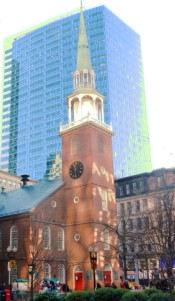 I detour Fen and Steven to the Omni Parker House, a dowager of a hotel that is said to be the birthplace of Parker rolls and Boston cream pie. I see neither on our brief foray into a darkly paneled lobby so we head out and cruise by the Old Corner Bookstore on our way to the Old South Meeting House, a tidy brick building whose clock tower marked the spot for the earliest protests of the tax on tea, an indignity which pushed colonists toward revolution in 1773. It’s still an active meeting house unlike the Old State House across the way, which was central to the American Revolution but now acts as a museum. The site of the Boston massacre is marked by a brass plaque embedded into the sidewalk and leads us to Faneuil Hall, our country’s cradle of liberty and where its first town meeting was held. The multi-story brick structure, which has been a meeting hall and marketplace for more than two centuries, sports its own mini golden dome and opens onto the more popular Quincy Market, a cradle of consumerism where latter-day shoppers can peruse the racks at the likes of Urban Outfitters and Gap.
I detour Fen and Steven to the Omni Parker House, a dowager of a hotel that is said to be the birthplace of Parker rolls and Boston cream pie. I see neither on our brief foray into a darkly paneled lobby so we head out and cruise by the Old Corner Bookstore on our way to the Old South Meeting House, a tidy brick building whose clock tower marked the spot for the earliest protests of the tax on tea, an indignity which pushed colonists toward revolution in 1773. It’s still an active meeting house unlike the Old State House across the way, which was central to the American Revolution but now acts as a museum. The site of the Boston massacre is marked by a brass plaque embedded into the sidewalk and leads us to Faneuil Hall, our country’s cradle of liberty and where its first town meeting was held. The multi-story brick structure, which has been a meeting hall and marketplace for more than two centuries, sports its own mini golden dome and opens onto the more popular Quincy Market, a cradle of consumerism where latter-day shoppers can peruse the racks at the likes of Urban Outfitters and Gap.
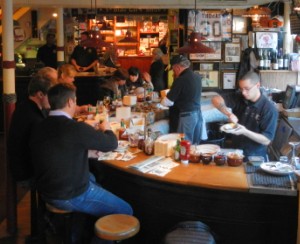 Having worked up an appetite, we stop at the Union Oyster House, where a plaque touts “the oldest continually-operated restaurant and oyster bar in the U.S.” It’s taken us less than two hours to figure out that everyone in Boston is keen to say they are the birthplace of the revolution or the oldest this-or-that, and it’s a show of hometown pride which is equal parts endearing and confusing. No matter, we know this restaurant was a favorite of President John F. Kennedy so we request a table and are seated at a high-walled booth in a small, second-floor dining room that is directly across from Kennedy’s favorite booth (a plaque marks the spot). Six 20-something Japanese tourists populate JFK’s space on this day and they eagerly slurp clam chowder, a favorite of the President. We order similarly and dig in.
Having worked up an appetite, we stop at the Union Oyster House, where a plaque touts “the oldest continually-operated restaurant and oyster bar in the U.S.” It’s taken us less than two hours to figure out that everyone in Boston is keen to say they are the birthplace of the revolution or the oldest this-or-that, and it’s a show of hometown pride which is equal parts endearing and confusing. No matter, we know this restaurant was a favorite of President John F. Kennedy so we request a table and are seated at a high-walled booth in a small, second-floor dining room that is directly across from Kennedy’s favorite booth (a plaque marks the spot). Six 20-something Japanese tourists populate JFK’s space on this day and they eagerly slurp clam chowder, a favorite of the President. We order similarly and dig in.
“Mom, I swear there’s sand in the soup,” grins Steven, acknowledging the sign of a truly authentic chowder.
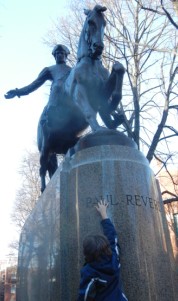 I work my way through potato-crusted, pan-seared haddock while husband and son inhale their heaping plates of fish ‘n chips. Before we leave, I wander among the many dining rooms on both the second and first floor, each a twist on colonial splendor. I linger longer at a crescent-shaped oyster bar near the front door and imagine what it must’ve been like 200 years ago and whether someone like myself would’ve even been welcomed to dine with gentlemen. I resist the temptation to buy a lobster magnet from the gift shop and we proceed to the North End, a longtime enclave of Italian immigrants and onetime home to Paul Revere. The aptly-named Paul Revere House dates to 1680 and is the oldest extant structure in downtown Boston. The Old North Church around the corner is the oldest church (and most visited historic site) in the city and the building whose steeple was the place from which Paul Revere’s signal was broadcast (“one if by land, two if by sea”), announcing the march of redcoats from Lexington and Concord which was the inevitable start, yes, of the American Revolution. The tidy brick church is well preserved and Fen pulls me into one of the pews to tell me that his mother was descended from Isaac Davis, the first American officer to die in the Revolutionary War. Finally, we head uphill to Copp’s Hill Burying Ground and look out to Bunker Hill before deciding to end our Freedom Trail trek and head back to the Fairmont.
I work my way through potato-crusted, pan-seared haddock while husband and son inhale their heaping plates of fish ‘n chips. Before we leave, I wander among the many dining rooms on both the second and first floor, each a twist on colonial splendor. I linger longer at a crescent-shaped oyster bar near the front door and imagine what it must’ve been like 200 years ago and whether someone like myself would’ve even been welcomed to dine with gentlemen. I resist the temptation to buy a lobster magnet from the gift shop and we proceed to the North End, a longtime enclave of Italian immigrants and onetime home to Paul Revere. The aptly-named Paul Revere House dates to 1680 and is the oldest extant structure in downtown Boston. The Old North Church around the corner is the oldest church (and most visited historic site) in the city and the building whose steeple was the place from which Paul Revere’s signal was broadcast (“one if by land, two if by sea”), announcing the march of redcoats from Lexington and Concord which was the inevitable start, yes, of the American Revolution. The tidy brick church is well preserved and Fen pulls me into one of the pews to tell me that his mother was descended from Isaac Davis, the first American officer to die in the Revolutionary War. Finally, we head uphill to Copp’s Hill Burying Ground and look out to Bunker Hill before deciding to end our Freedom Trail trek and head back to the Fairmont.
Our room for the week is the Catie Copley Suite, named after the hotel’s canine ambassador and all-around sweet black Labrador. Catie spends most of her time greeting guests in the lobby and, on opening the door to the eponymous third-floor suite, we’re greeted by a watercolor of Catie in her signature red collar. To the left, an L-shaped, eggplant-colored velour couch takes center stage. The room’s pearl gray walls are adorned with photos of Catie and prints from her two books, with more photos resting on a dresser and in a bookcase. A small dining table is flanked by a pair of shimmering leather chairs and silver accents predominate. A bedroom to the right showcases a king bed wrapped in winter white and paired with dark wood furnishings as a pair of wing chairs beckon.
“This is sweet!” Steven calls out from his side of the suite and we have to agree. If there is a more welcoming accommodation for families in the heart of Boston, I can’t imagine it.
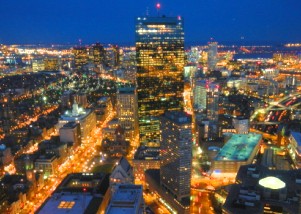 We arrive at the Skywalk Observatory, 50 floors up in the Prudential Building, just before sunset and dash madly from one side of the building to the next to take in the view from every angle. Hand-held audio devices explain it all but we feel like old hands as we spot Boston Common, the John Hancock Building and Fenway Park. Interactive storyboards tell the Boston story, and the telling is especially compelling when it comes to Boston sports teams. We repair to the Top of the Hub lounge on the 52nd floor for an early Christmas Eve dinner and snag a table snug against floor-to-ceiling glass windows. City lights wink in the distance as we feast on a smoked salmon and potato appetizer and follow it with a chesnut puree with duck confit that is sweet and creamy and dances with flavor. A butternut squash tortellini over short ribs is as warming as the room, its low tables paired with quilted leather chairs that invite you to press in for conversation. A three-piece jazz combo starts to play and, as I turn for a look, I see the room is full to bursting.
We arrive at the Skywalk Observatory, 50 floors up in the Prudential Building, just before sunset and dash madly from one side of the building to the next to take in the view from every angle. Hand-held audio devices explain it all but we feel like old hands as we spot Boston Common, the John Hancock Building and Fenway Park. Interactive storyboards tell the Boston story, and the telling is especially compelling when it comes to Boston sports teams. We repair to the Top of the Hub lounge on the 52nd floor for an early Christmas Eve dinner and snag a table snug against floor-to-ceiling glass windows. City lights wink in the distance as we feast on a smoked salmon and potato appetizer and follow it with a chesnut puree with duck confit that is sweet and creamy and dances with flavor. A butternut squash tortellini over short ribs is as warming as the room, its low tables paired with quilted leather chairs that invite you to press in for conversation. A three-piece jazz combo starts to play and, as I turn for a look, I see the room is full to bursting.
“I love it here,” I coo.
“Who doesn’t?” deadpans Steven.
Tuesday
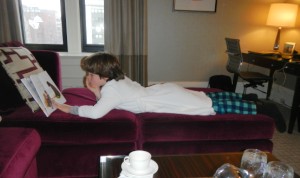 Steven awakens on Christmas morning and bounds into our bedroom. He casts about for presents but, alas, I haven’t brought any. I pivot to ordering a pot of hot chocolate from room service and dash off to the hotel gift shop in search of, well, anything. A staffer, Seamus, points me to Catie Copley’s two tomes and we quickly combine them with a red Fairmont ornament and a box of red and green ribbon candy. He wraps it all up and, minutes later, the package arrives in our room, Steven’s smile a mile wide once he sees the books. We take turns reading them over an impromptu breakfast of homemade muffins and steaming mugs of cocoa.
Steven awakens on Christmas morning and bounds into our bedroom. He casts about for presents but, alas, I haven’t brought any. I pivot to ordering a pot of hot chocolate from room service and dash off to the hotel gift shop in search of, well, anything. A staffer, Seamus, points me to Catie Copley’s two tomes and we quickly combine them with a red Fairmont ornament and a box of red and green ribbon candy. He wraps it all up and, minutes later, the package arrives in our room, Steven’s smile a mile wide once he sees the books. We take turns reading them over an impromptu breakfast of homemade muffins and steaming mugs of cocoa.
Midday, we cross the Public Garden and Common once again, this time headed for Chinatown and the Winsor Dim Sum Cafe. Living up to its reputation as a go-to destination for Chinese food and possibly because it’s Christmas Day, we wait 30 minutes for a table. Once seated, we quickly realize it was worth the wait. The small, spare room is jammed with tables and, in no time, our orders of steaming dumplings stream out of the kitchen, a medley of shrimp, chives and spinach. Gossamer noodles swirl in a garlicky sauce while eggplant soaks in oyster sauce, and lacquered spare ribs match beautifully with a black bean sauce. We leave the best, a plate of doughy pork buns, for last.
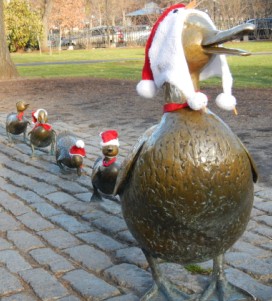 Our walk back to the hotel in the early afternoon has us zigzagging through Chinatown in search of the perfect walnut cookies (we hit pay dirt at a place with no apparent name), then cut through the Theater District and past Downtown Crossing’s stalwart stores, Macy’s and Filene’s. Holiday strollers are everywhere, and almost every woman is wearing an of-the-moment puffer coat to ward off the winter chill. When we reach the State House, we climb Joy and Mt. Vernon Streets on our way to Louisburg Square, the heart and soul of Beacon Hill. Secretary of State John Kerry owns a home on the Square and it’s easy to imagine the patrician elder statesman in one of the graceful, centuries-old townhouses. A nattily-dressed couple exits one of the homes along with two teenagers and an adorable pooch.
Our walk back to the hotel in the early afternoon has us zigzagging through Chinatown in search of the perfect walnut cookies (we hit pay dirt at a place with no apparent name), then cut through the Theater District and past Downtown Crossing’s stalwart stores, Macy’s and Filene’s. Holiday strollers are everywhere, and almost every woman is wearing an of-the-moment puffer coat to ward off the winter chill. When we reach the State House, we climb Joy and Mt. Vernon Streets on our way to Louisburg Square, the heart and soul of Beacon Hill. Secretary of State John Kerry owns a home on the Square and it’s easy to imagine the patrician elder statesman in one of the graceful, centuries-old townhouses. A nattily-dressed couple exits one of the homes along with two teenagers and an adorable pooch.
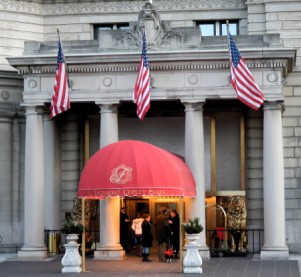 While we managed to have Christmas presents materialize in the nick of time, the Fairmont gave itself a 100th-birthday present in 2012. A $20 million renovation took in the guest rooms and main hallway (uncovering a gorgeously-tiled floor in the latter) and created a cozy library cum sitting room off the front desk. A navy settee in the sitting room is deep and comfortable and paired with a robin’s-egg-blue bench. Steps away, another discrete seating area sports ruby red wing chairs and a long herringbone couch. The adjacent library is a cozy cube and Catie Copley is steps away, regaling guests as they come and go. It’s no surprise that our family of three manages to while away the afternoon in this serene setting. Later that evening, dinner at OAK Long Bar + Kitchen at the Fairmont is a feast for the senses. A cavernous restaurant with a molded ceiling that harkens to another era, the room shifts from masculine (hard angles, dark tones) to feminine (Martha Stewart hues, crisp fabrics) and never loses sight of the long bar at its center, recently fitted with sinfully-rich chocolate brown leather stools that allow you to sit solo or a deux. We opt for a table on the Martha Stewart side of the room and partake of a bowl of mussels swimming in a fennel broth flecked with onions and tomatoes that could easily be Best of Boston. Our server returns with oven-roasted, olive oil-infused bread so we can sop up the broth. My roasted half chicken is succulent and paired with roasted potatoes, and Fen’s 16-oz. ribeye is adorned with bone marrow, a slick of blue cheese and plump onion rings. I poach a few bites of beef as Steven waxes eloquent over the OAK burger, a fistful of meaty goodness that my growing boy polishes off. Bellies full, we climb a grand staircase to the warm embrace of the Catie Copley Suite.
While we managed to have Christmas presents materialize in the nick of time, the Fairmont gave itself a 100th-birthday present in 2012. A $20 million renovation took in the guest rooms and main hallway (uncovering a gorgeously-tiled floor in the latter) and created a cozy library cum sitting room off the front desk. A navy settee in the sitting room is deep and comfortable and paired with a robin’s-egg-blue bench. Steps away, another discrete seating area sports ruby red wing chairs and a long herringbone couch. The adjacent library is a cozy cube and Catie Copley is steps away, regaling guests as they come and go. It’s no surprise that our family of three manages to while away the afternoon in this serene setting. Later that evening, dinner at OAK Long Bar + Kitchen at the Fairmont is a feast for the senses. A cavernous restaurant with a molded ceiling that harkens to another era, the room shifts from masculine (hard angles, dark tones) to feminine (Martha Stewart hues, crisp fabrics) and never loses sight of the long bar at its center, recently fitted with sinfully-rich chocolate brown leather stools that allow you to sit solo or a deux. We opt for a table on the Martha Stewart side of the room and partake of a bowl of mussels swimming in a fennel broth flecked with onions and tomatoes that could easily be Best of Boston. Our server returns with oven-roasted, olive oil-infused bread so we can sop up the broth. My roasted half chicken is succulent and paired with roasted potatoes, and Fen’s 16-oz. ribeye is adorned with bone marrow, a slick of blue cheese and plump onion rings. I poach a few bites of beef as Steven waxes eloquent over the OAK burger, a fistful of meaty goodness that my growing boy polishes off. Bellies full, we climb a grand staircase to the warm embrace of the Catie Copley Suite.
Wednesday
The John F. Kennedy Presidential Library and Museum sits on Columbia Point overlooking Boston harbor. Our 35th president, an impressive man by most accounts, would be duly impressed by the retelling of his story at this, one of 13 presidential libraries. A 17-minute documentary film launches our visit and is narrated largely by Kennedy, his voice-over adding depth to newsreel footage. The story is well known: one of nine children of an overachieving, domineering father, JFK went on to Harvard and the Navy before entering politics. A stint in Congress was wrapped around a wedding (to the lovely Jackie) and a book (“Profiles in Courage”) and served to groom a young man who often waxed eloquent: “We enjoy the comfort of opinion without the discomfort of thought,” he is heard saying, words that echo loudly to this day. Near the end of the film, Steven leans over and whispers, “Mom, why would anyone want to kill him?”
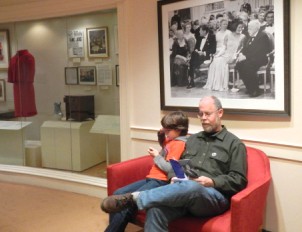 A series of exhibits are arrayed in the museum’s lower level and begin with the 1960 Democratic National Convention in Los Angeles, a simpler time as evinced by totems including 45s, Pond’s Cold Cream and PaperMate pens. The early 60s memorabilia is great and amuses Steven, and is in stark relief to TVs playing the Kennedy-Nixon debates. JFK’s victory was narrow yet real, making him the country’s youngest president at the age of 43 and the first Catholic to hold the office. A series of video clips offer signs of the times: Walter Cronkite, dewy-eyed on election night, and the president’s seminal inaugural speech (“Let us never negotiate out of fear...” “Ask not what your country can do...”). Equally moving, and a new addition to the museum, is “In Her Voice: Jacqueline Kennedy, The White House Years,” an audio-visual exhibit of recordings made by the first lady with Arthur Schlesinger, Jr. in early 1964 and released to the public in 2011. The many flash points the president endured, and largely overcame – the Cuban missile crisis, Berlin, Vietnam – leave us awestruck, as do the countless challenges he embraced including launching the Peace Corps and daring a nation to reach for the moon. Memorabilia including gifts to the first couple of jewelry and other riches are dazzling, as are the many photos and personal effects of the president and a faithful re-creation of his Oval Office. And yet, it’s Jackie who steals the show, her breathy voice offering dizzying insights into what it was like to be so close to the seat of power and, at times, so far. I linger over a photo of the president and the first lady at a gala White House event, seated between the writer Pearl S. Buck and the poet Robert Frost.
A series of exhibits are arrayed in the museum’s lower level and begin with the 1960 Democratic National Convention in Los Angeles, a simpler time as evinced by totems including 45s, Pond’s Cold Cream and PaperMate pens. The early 60s memorabilia is great and amuses Steven, and is in stark relief to TVs playing the Kennedy-Nixon debates. JFK’s victory was narrow yet real, making him the country’s youngest president at the age of 43 and the first Catholic to hold the office. A series of video clips offer signs of the times: Walter Cronkite, dewy-eyed on election night, and the president’s seminal inaugural speech (“Let us never negotiate out of fear...” “Ask not what your country can do...”). Equally moving, and a new addition to the museum, is “In Her Voice: Jacqueline Kennedy, The White House Years,” an audio-visual exhibit of recordings made by the first lady with Arthur Schlesinger, Jr. in early 1964 and released to the public in 2011. The many flash points the president endured, and largely overcame – the Cuban missile crisis, Berlin, Vietnam – leave us awestruck, as do the countless challenges he embraced including launching the Peace Corps and daring a nation to reach for the moon. Memorabilia including gifts to the first couple of jewelry and other riches are dazzling, as are the many photos and personal effects of the president and a faithful re-creation of his Oval Office. And yet, it’s Jackie who steals the show, her breathy voice offering dizzying insights into what it was like to be so close to the seat of power and, at times, so far. I linger over a photo of the president and the first lady at a gala White House event, seated between the writer Pearl S. Buck and the poet Robert Frost.
“He made a big impression, didn’t he?” says Steven.
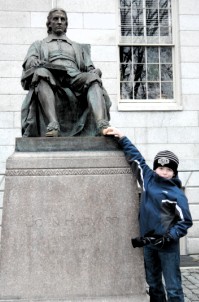 The red line, one of several Boston subway lines affectionately referred to as “the T,” whisks us away from the museum and deposits us at Harvard Square. If we’re trying to inspire our son to follow in JFK’s footsteps, no one says it and we make our way to Grendel’s Den, a longtime favorite of the Birkenstock set, for a lunch of homemade soup and sandwiches. The university campus is quiet during the holiday break and the quad is empty save for a gaggle of visitors arrayed around a statue of John Harvard. Tradition has it that if you rub Harvard’s toe, you’ll have good luck at exam time. Consequently, the toe is gleaming on an otherwise washed-out bronze and Steven reaches for his date with good fortune. The Coop, Harvard’s one-stop shop for books, is as good as Fen and I remember and we sift through the selection for nearly an hour as we take in snippets of conversation in languages we barely comprehend.
The red line, one of several Boston subway lines affectionately referred to as “the T,” whisks us away from the museum and deposits us at Harvard Square. If we’re trying to inspire our son to follow in JFK’s footsteps, no one says it and we make our way to Grendel’s Den, a longtime favorite of the Birkenstock set, for a lunch of homemade soup and sandwiches. The university campus is quiet during the holiday break and the quad is empty save for a gaggle of visitors arrayed around a statue of John Harvard. Tradition has it that if you rub Harvard’s toe, you’ll have good luck at exam time. Consequently, the toe is gleaming on an otherwise washed-out bronze and Steven reaches for his date with good fortune. The Coop, Harvard’s one-stop shop for books, is as good as Fen and I remember and we sift through the selection for nearly an hour as we take in snippets of conversation in languages we barely comprehend.
Trekking back to the North End for dinner, we find Antico Forno packed with fans of the restaurant’s cooking. The décor follows the trattoria playbook: faux brick archways, low ceilings, a warm glow. Kids are barely noticed amid the din, and an L-shaped bar in the back is where couples nuzzle over a glass of chianti. Our antipasti of meatballs in a red sauce laced with red peppers and paired with the lightest arugula is so delicious I seriously consider ordering a second but Fen’s sensibility prevails. Instead, I flag down our waitress and ask her for a side of roasted potatoes that are calling to me from the next table. Soon, we are greeted with three individual, thin-crust pizzas, mine topped with wilted spinach, fresh mozzarella and cherry tomatoes while Fen’s is meatier, a seasoned sausage predominating. Steven sticks to the classic Margherita and it’s really anyone’s guess as to which pizza is best. The restaurant is half-empty by the time we finish our tiramisu and we pad out into the night, giddy with satisfaction.
Thursday
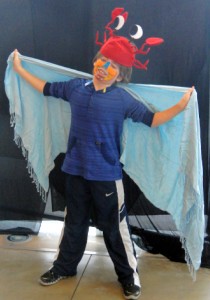 The Institute of Contemporary Arts (ICA) is the kind of place that meets everyone at their level. No highbrow hijinks here, rather, accessible art that’s more playful than preachy. Situated amid waterfront development that is a work in progress, the building is a cube appended by a cantilever that’s a play of glass and stone allowing light, and mood, to shift. On the first floor, the Bank of America Art Lab was designed with the Massachusetts Institute of Art and Design as a fertile space for young minds. On this day, both children and adults are invited to make creative portraits by first having their picture snapped (nearby boxes are filled with face paints, silly lobster hats and assorted scarves and sunglasses) and, later. manipulating the large print with mixed media including colored pens, craft paper and ornate scraps. Steven primps then poses for the camera and we then proceed to the upper floors, where permanent and rotating exhibits range from musician-artist Ragnar Kjartansson’s riffs on world beats to Mickalene Thomas’ beaded canvases of strong black women and Tara Donovan’s washer-dryer-sized cube made up of thousands of straight pins bound only by gravity. Returning to the Art Lab, Steven gets to work on his photo at a long table and is soon joined by a maybe five-year-old boy named Jacob who keeps calling out for “assistance!” in the form of his bemused mother. An effusive sort, Jacob tells anyone willing to listen that he’s working on “Superhero Jacob,” which turns out to be an alter ego that’s worthy of immediate framing and a fast pass to the master class. Steven’s effort is more than commendable and a breezy two hours after we’ve arrived, we repair to the museum’s Water Cafe, a modern, light-filled space that’s awash in white wood and glass and with which I immediately bond. A Tuscan bread soup with sausage, canellini beans and carrots is a winner as is a smoked turkey sandwich with bacon, avocado and chipotle aioli that’s served with greens napped in the lightest dressing.
The Institute of Contemporary Arts (ICA) is the kind of place that meets everyone at their level. No highbrow hijinks here, rather, accessible art that’s more playful than preachy. Situated amid waterfront development that is a work in progress, the building is a cube appended by a cantilever that’s a play of glass and stone allowing light, and mood, to shift. On the first floor, the Bank of America Art Lab was designed with the Massachusetts Institute of Art and Design as a fertile space for young minds. On this day, both children and adults are invited to make creative portraits by first having their picture snapped (nearby boxes are filled with face paints, silly lobster hats and assorted scarves and sunglasses) and, later. manipulating the large print with mixed media including colored pens, craft paper and ornate scraps. Steven primps then poses for the camera and we then proceed to the upper floors, where permanent and rotating exhibits range from musician-artist Ragnar Kjartansson’s riffs on world beats to Mickalene Thomas’ beaded canvases of strong black women and Tara Donovan’s washer-dryer-sized cube made up of thousands of straight pins bound only by gravity. Returning to the Art Lab, Steven gets to work on his photo at a long table and is soon joined by a maybe five-year-old boy named Jacob who keeps calling out for “assistance!” in the form of his bemused mother. An effusive sort, Jacob tells anyone willing to listen that he’s working on “Superhero Jacob,” which turns out to be an alter ego that’s worthy of immediate framing and a fast pass to the master class. Steven’s effort is more than commendable and a breezy two hours after we’ve arrived, we repair to the museum’s Water Cafe, a modern, light-filled space that’s awash in white wood and glass and with which I immediately bond. A Tuscan bread soup with sausage, canellini beans and carrots is a winner as is a smoked turkey sandwich with bacon, avocado and chipotle aioli that’s served with greens napped in the lightest dressing.
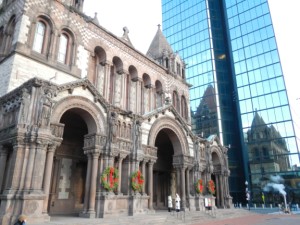 We take the T back to our Back Bay neighborhood, approaching the latter via the stately rectangle that is the Public Garden, its statues and shrubbery a model of New England rectitude. The brownstones that line Commonwealth Avenue, a broad boulevard, are wrapped in holiday finery, their wreaths and garlands in keeping with the wealth and good taste of their owners. Cutting over to Newbury Street, a fashionista’s dream, we gravitate toward the North Face and Converse stores, each sporting a kaleidoscopic display of our favorite brands. A stop at Emack & Bolio’s ice cream emporium sweetens the deal and, making a final turn onto Boylston Street, we come face to face with Trinity Church, dating to 1877 and considered the birthplace of Richardsonian Romanesque architecture, all soaring arches and towers that are replayed in buildings across the U.S. We’ve been looking down at the church and its reflection in the Hancock building from our hotel window for the better part of a week, but it’s far more satisfying from street level.
We take the T back to our Back Bay neighborhood, approaching the latter via the stately rectangle that is the Public Garden, its statues and shrubbery a model of New England rectitude. The brownstones that line Commonwealth Avenue, a broad boulevard, are wrapped in holiday finery, their wreaths and garlands in keeping with the wealth and good taste of their owners. Cutting over to Newbury Street, a fashionista’s dream, we gravitate toward the North Face and Converse stores, each sporting a kaleidoscopic display of our favorite brands. A stop at Emack & Bolio’s ice cream emporium sweetens the deal and, making a final turn onto Boylston Street, we come face to face with Trinity Church, dating to 1877 and considered the birthplace of Richardsonian Romanesque architecture, all soaring arches and towers that are replayed in buildings across the U.S. We’ve been looking down at the church and its reflection in the Hancock building from our hotel window for the better part of a week, but it’s far more satisfying from street level.
Stella in the South End is the setting for our final dinner in Boston and the restaurant’s clean lines and modern yet approachable menu are a window on the edgy neighborhood. My grilled octopus starter sets the table for a lamb shank nestled against a mushroom risotto and I want for nothing more as I savor the room with husband and son.
Friday
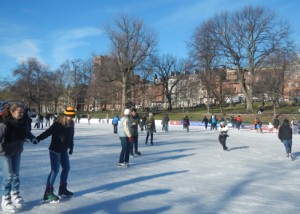 A small crowd has assembled at Frog Pond on Boston Common just before 10 a.m. as a Zamboni polishes the ice to a dewy sheen. Soon, the gates open and we pour onto the ice under clear blue skies. This oval is filled with several inches of water save for the winter months, when it’s topped with a sheet of ice that’s packed from morning till night. The State House and Beacon Hill brownstones serve as backdrop and we circle to our heart’s content. Fen and I choose to hold hands, affirming what we already know: it’s the most wonderful time of the year, and we chose the ideal place in which to spend it.
A small crowd has assembled at Frog Pond on Boston Common just before 10 a.m. as a Zamboni polishes the ice to a dewy sheen. Soon, the gates open and we pour onto the ice under clear blue skies. This oval is filled with several inches of water save for the winter months, when it’s topped with a sheet of ice that’s packed from morning till night. The State House and Beacon Hill brownstones serve as backdrop and we circle to our heart’s content. Fen and I choose to hold hands, affirming what we already know: it’s the most wonderful time of the year, and we chose the ideal place in which to spend it.
Details
Fairmont Copley Plaza, 138 St. James Avenue, Boston, Ma. 02116 (617) 267-5300 http://www.fairmont.com/copley-plaza-boston/ Doubles from $187; package rates and Internet specials available. OAK Long Bar + Kitchen serves breakfast, lunch and dinner; new rooftop health club.
The Freedom Trail begins in front of the Boston Common Visitor Information Center at 139 Tremont Street. An official guide, as well as guided tours, are available from the Freedom Trail Foundation http://www.thefreedomtrail.org/; call (617) 357-8300 for tour reservations.
Union Oyster House, 41 Union Street, Boston (617) 227-2750 http://www.unionoysterhouse.com/ Open for lunch and dinner seven days.
Skywalk Observatory, 800 Boylston Street, Boston (617) 638-3288 http://www.prudentialcenter.com/shop/shop_detail.php?id=64 The observatory is open daily and is part of the Boston CityPASS, which includes admission to five attractions http://www.citypass.com/boston
Top of the Hub, 800 Boylston Street, Boston (617) 536-1775 http://www.topofthehub.net/ Open seven days for lunch, dinner and late night.
Winsor Dim Sum Cafe, 10 Tyler Street, Boston (617) 338-1688 Open 9 a.m.-10 p.m. seven days.
John F. Kennedy Presidential Library and Museum, 220 Morrissey Boulevard., Boston (617) 514-1600 http://www.jfklibrary.org/ Open 9 a.m.-5 p.m. daily. The red line subway gets you close to the museum, at which point you can transfer onto a free shuttle bus for door-to-door service. Plan on a minimum half day for your visit.
Grendel’s Den, 89 Winthrop Street, Cambridge (617) 491-1160 http://www.grendelsden.com/ Open daily for lunch, dinner and late night.
Antico Forno, 93 Salem Street, Boston (617) 723-6733 http://www.anticofornoboston.com/ Open for lunch and dinner seven days.
Institute of Contemporary Arts, 100 Northern Avenue, Boston (617) 478-3100 http://www.icaboston.org/ Closed Monday, open until 9 p.m. on Thursday and Friday. The Water Cafe keeps the same hours as the museum, as does the well-stocked gift shop.
Stella, 1525 Washington Street, Boston (617) 247-7747 http://www.bostonstella.com/experience.html Open for dinner nightly.
Frog Pond, 84 Beacon Street (617) 635-2120 http://www.bostonfrogpond.com/info Open daily for skating during the winter season (generally 10 a.m.-9 p.m. but it’s best to call for hours), with skate and locker rentals available. The pond acts as a reflecting pool in the spring and fall, and a spray pool with nearby children’s carousel during the summer months. The Frog Pond Cafe is adjacent.
![]()
Elaine Labalme is a food and travel writer based in Pittsburgh, PA . When she's not busy as a domestic goddess she's out traveling with husband Fen and eleven-year-old son Steven. She hopes to be the next Charles Kuralt.
Note: This information was accurate when it was published. Please be sure to confirm all rates and details directly with the businesses in question before making your plans.



